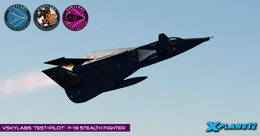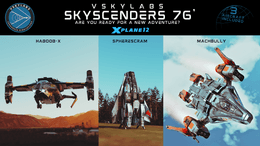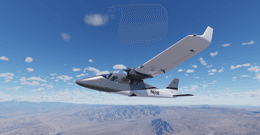$14
VSKYLABS Test-Pilot: Aeros-2 Trike Project
The VSKYLABS 'Test-Pilot': Aeros-2 Trike Project
JetManHuss - VSKYLABS (c) 2024 All Rights Reserved.
Powered Hang Glider Trike Simulation
Separate native products for X-PLANE 12 and X-PLANE 11, for your selection.
MINIMUM HARDWARE REQUIREMENTS FOR X-PLANE 12
Disk Space: 25GB
CPU: Intel Core i3, i5, i7, or i9 CPU with 4 or more cores, or AMD Ryzen 3, 5, 7 or 9.
(Those with other CPUs should try the demo before purchasing.)
Memory: 8 GB RAM
Video Card: a Vulkan 1.3-capable video card from NVIDIA or AMD with at least 2 GB VRAM
Note: Intel GPUs are not supported by X-Plane 12.
The development of the VSKYLABS 'Test-Pilot': Aeros-2 Project for X Plane 11 was approved by 'Aeros Ltd.'. However, it is an independent VSKYLABS project which is not affiliated and/or endorsed with/by 'Aeros Ltd.'.
What is an Ultralight Hang Gliger Trike aircraft?
An ultralight trike aircraft, also known as a flex-wing trike, weight-shift-control aircraft, microlight trike, deltatrike or motorized deltaplane, is a type of powered hang glider using a high-performance Rogallo wing coupled to a propeller-driven three-wheeled undercarriage. While many powered aircraft have three-wheeled landing gear, the term "trike" refers specifically to the form of aircraft described above.
Flight control in a trike is made by weight-shifting; the undercarriage structure is connected to the wing at a hinge-point, and the wing can be tilted in both X and Y axes. While on the ground (takeoff for example), pushing the wing control bar raises the angle of attack of the wing and lift is produced. As the aircraft is airborne, moving the control bar of the wing causes the undercarriage to swift both sideways or back and forth, and a weight-shifting control is achieved.
Project Main Features
- VSKYLABS development for X-Plane approved by 'Aeros Ltd' company (however, it is an independent VSKYLABS project, not affiliated and/or endorsed with/by 'Aeros Ltd.')
- High end simulation of the Aeros-2 Ultralight Trike, powered by a Rotax 503 50hp engine.
- Designed with the focus on control and handling characteristics, excellent for basic and advanced hang glider trike training / conversion from fixed wing aircraft.
- Real-Physics, incorporating weight shifting and wing simulation of a hang-glider trike.
- Additional passenger which can be removed, to simulate light vs heavy trike operations.
- Rescue system (Ballistic Magnum 450 system).
- Unique trike flying aspects are being simulated: stalls, slips, spins and tumbling.
Project Highlights
- VSKYLABS 'Test-Pilot' Project: designed for use with X-Plane cutting edge flight model environment, features superb flight dynamics with authentic performance and flight handling characteristics.
- Built for VR: development was tailored specifically for VR, and optimized for 2D usage.
- Engineered and designed as a default X-Plane aircraft (Like all VSKYLABS projects). The VSKYLABS projects are practically show-casing X-Plane, as they are stretching X-Plane default features, systems and flight model to its limits...delivering a very robust simulation model, having maximum compatibility with the ever evolving X-Plane flight simulator.
- Pilot / Pilot+passenger configuration: The Aeros-2 is a two-seat trike. The VSKYLABS Aeros-2 is designed to allow single and dual pilot configuration. While flown light, or fully loaded, the VSKYLABS Aeros-2 is demonstrating authentic flight performance and handling characteristics, with realistic CG distribution.
- Built-in Avitab Plugin Compatibility (AviTab plugin is not included).
- Autoupdater based on the SkunkCrafts autoupdater (XP12 only) - all updates are being pushed smoothly without the need to re-download the entire base package (base package will be updated every once in a while to minimize the gap).
- Highly responsive VSKYLABS support forums: Professional discussions which results in incorporating users feedback into the on-going scheduled development plan. Real-pilots inputs (as well as sim-pilots feedback) are always welcome, and in practice sets the the VSKYLABS projects within solid, professional margins over time.
Extra reading / watching / learning
Recommended YouTube videos for getting familiar with this beautiful flying machine. Links are from the channel of Paul Hamilton. The videos are Non-VSKYLABS and they are presented *As-Is*, for educational purposes:
Taxi and takeoff
Trike intro flight
How to land a Trike
Engine out emergency - Dead stick landing
Pilot's Operating Handbook
The VSKYLABS Aeros-2 Trike Project - POH / Manual
Update Log
VSKYLABS 'Test-Pilot': Aeros-2 Trike Project
JetManHuss - VSKYLABS (c) 2024 All Rights Reserved.
XP12 - v2.2c (24th March 2024):
- Bug fix - Passenger hide/show works properly now with the management of passenger weight in the GUI.
XP12 - v2.2a (19th January 2023):
- FMOD sound improvements for the engine.
- Bug fix - passenger visor still visible when the passenger is gone.
- Bug fix - instruments appearance at night was buggy.
XP12 - v2.2 (4th December 2022):
- Interior lighting system reset and retuned to comply with the modified X-Plane 12.00r1+ lighting engine.
XP12 - v2.1 (23th November 2022):
- Updater software replaced - from STMA to SkunkCrafts.
XP12 - v2.0 (September 2022):
- X-Plane 12 intial version released.
XP11 - v1.07a (2nd July 2020):
- AviTab smartphone visualization:
- Now can be toggled (visibility) by using key assignment for 'Toggle seatbelt sign".
XP11 - v1.07c (9th April 2020):
- Flight model tuneup:
- Left toe brake axis is now affecting both brakes for *all-wheel-braking* while using a single brake pedal.
XP11 - v1.07 - (29th October 2019):
- Flight model tuneup:
- Dynamic control bar resistance was added, to emulate the excessive forces on the control bar while flying in high-speed. As speed goes higher, control bar is getting "tougher", right until the point that if the Trike is flying leveled, a high-speed Vne dive could not be executed, as the wing forces will "win", while bringing the nose up.
XP11 - v1.05 - (27th October 2019):
- Flight model tuneup:
- Overall drag tuneup to match exact gliding ratio (to follow POH) with greater precision.
- Dynamic bar operation envelope for more solid and stable flight, especially in the higher speeds. This has also fixed the tendency for tumbling when pulling the bar gradually during descent.
- Various performance tune-ups.
XP11 - v1.01 (4th October 2019):
- Electrical wiring fix - DG is now working properly when starting cold and dark.
XP11 - v1.0 (3rd October 2019): Initial Version Release.




